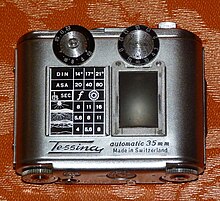
In photography, the sunny 16 rule (also known as the sunny f/16 rule) is a method of estimating correct daylight exposures without a light meter. Apart from the advantage of independence from a light meter, the sunny 16 rule can also aid in achieving correct exposure of difficult subjects. As the rule is based on incident light, rather than reflected light as with most camera light meters, very bright or very dark subjects are compensated for. The rule serves as a mnemonic for the camera settings obtained on a sunny day using the exposure value (EV) system.
Using the rule
The basic rule is, "On a sunny day set aperture to f/16 and shutter speed to the ISO film speed for a subject in direct sunlight." In simplest terms, bright sun = f:16 @ 1/film-speed-number (aperture and shutter speed, respectively).
For example:
- On a sunny day at ISO 100 ("100 speed film"), the aperture is set to f/16 and the shutter speed (i.e. exposure time) to 1/100 or 1/125 seconds (on some cameras 1/125 second is the closest available setting to 1/100 second).
- On a sunny day at ISO 200 and aperture at f/16, set shutter speed to 1/200 or 1/250.
- On a sunny day at ISO 400 and aperture at f/16, set shutter speed to 1/400 or 1/500.
Shutter speeds can be changed as long as the f-number is adjusted accordingly, e.g. 1/250 second at f/11 gives equivalent exposure to 1/125 second at f/16. Exposure adjustments are done in a manner that retains the EV. As the aperture is opened (f:11, f:5.6, f:4, etc.) the shutter-speed/exposure-time is reduced by a factor of approximately one-half (1/250, 1/500, 1/1000, etc.) This follows the mathematical relationship between aperture and shutter speed where exposure is inversely proportional to the square of the aperture ratio and proportional to exposure time; thus, to maintain a constant level of exposure, a change in aperture by a factor c requires a change in exposure time by a factor 1/c and vice versa. A change in the aperture of 1 stop always corresponds to a factor close to the square root of 2, thus the above rule.
Alternative rule
The sunny 16 rule can be used in varying light by setting the shutter speed nearest to the ISO film speed and f-number according to a generalized exposure table, as:

Aperture Lighting conditions Shadow detail f/22 Snow/sand Dark with sharp edges f/16 Sunny Distinct f/11 Slight overcast Soft around edges f/8 Overcast Barely visible f/5.6 Heavy overcast No shadows f/4 Open shade/sunset No shadows Add one stop Backlighting n/a
See also
References
- Bernhard J. Suess (2003). Mastering Black-and-White Photography. Allworth Communications. ISBN 1-58115-306-6.
- Shaw, John (2000). John Shaws's Nature Photography Field Guide. Amphoto Bookds. p. 16. ISBN 0-8174-4059-3.
- James Martin (2004). Digital Photography Outdoors: A Field Guide for Travel and Adventure Photographers. The Mountaineers Books. ISBN 978-0-89886-974-3.
- Chris Bucher (2007). Lighting Photo Workshop. John Wiley and Sons. p. 58. ISBN 978-0-470-11433-9.
- Ilford Manual of Photography p. 415, 1981
External links
- Guide to Photography Sunny 16 and film exposure guide.